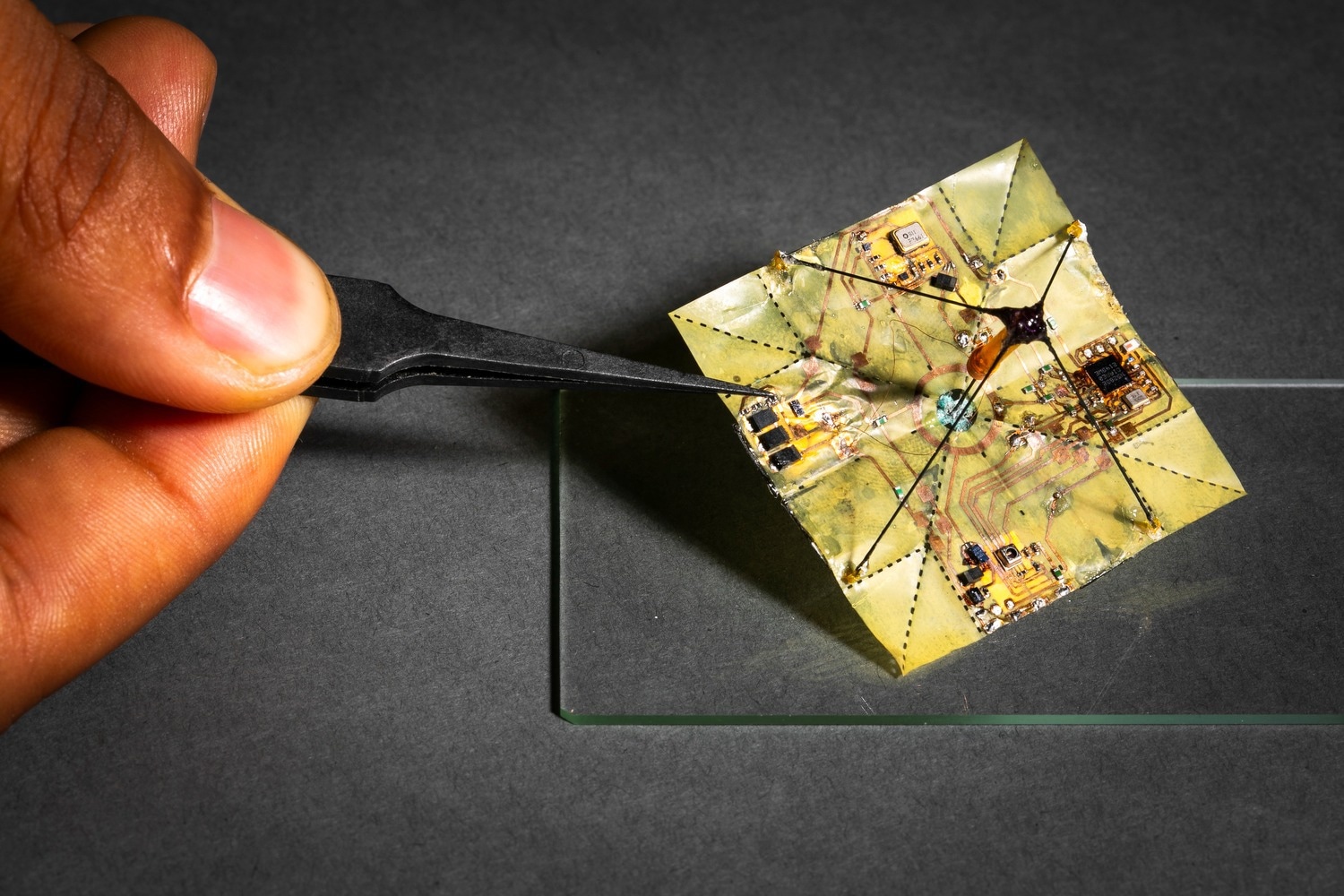
UW researchers developed small robotic devices that can change how they move through the air by “snapping” into a folded position during their descent. Each device has an onboard battery-free actuator, a solar power-harvesting circuit, and a controller to trigger these shape changes in mid-air. Shown here is a “microflier” in the unfolded state. Image Credit: Mark Stone/University of Washington
For the fliers to be spread out, the scientists regulate the timing of every device’s transition by making use of a few methods: an onboard pressure sensor (estimating altitude), an onboard timer, or a Bluetooth signal.
Microfliers weigh around 400 mg—around half as heavy as a nail—and could travel the distance of a football field while being dropped from 40 m (around 131 ft) in a light breeze. Every device consists of an onboard battery-free actuator, a solar power-harvesting circuit, and a controller to activate such shape changes in mid-air.
Also, Microfliers can take onboard sensors to survey humidity, temperature, and other conditions while flying.
The research group reported these outcomes in the Science Robotics journal on September 13th, 2023.
Using origami opens up a new design space for microfliers. We combine the Miura-ori fold, which is inspired by geometric patterns found in leaves, with power harvesting and tiny actuators to allow our fliers to mimic the flight of different leaf types in mid-air. In its unfolded flat state, our origami structure tumbles chaotically in the wind, similar to an elm leaf.
Vikram Iyer, Study Co-Senior Author and Assistant Professor, Paul G. Allen School of Computer Science & Engineering, University of Washington
Iyer added, “But switching to the folded state changes the airflow around it and enables a stable descent, similarly to how a maple leaf falls. This highly energy efficient method allows us to have battery-free control over microflier descent, which was not possible before.”
These robotic systems address numerous design challenges:
- The devices are very stiff to avoid accidentally shifting to the folded state before the signal.
- They transition between states quickly. The devices’ onboard actuators require just around 25 milliseconds to initiate the folding.
- The devices alter shape while untethered from a power source. The microfliers’ power-harvesting circuit makes use of sunlight to offer energy to the actuator.
The present microfliers could just transition in one direction—from the tumbling state to the falling state. This switch enables scientists to simultaneously regulate the descent of multiple micro-fliers so they disperse in various directions on their way down.
According to the scientists, future devices will be able to shift in both directions. This added functionality will enable highly precise landings in turbulent wind conditions.
The additional co-authors on this study are Kyle Johnson and Vicente Arroyos, both UW doctoral students in the Allen School; Amélie Ferran, a UW doctoral student in the mechanical engineering department; Raul Villanueva, Dennis Yin, and Tilboon Elberier.
Elberier completed this work as a UW undergraduate student studying electrical and computer engineering; Alberto Aliseda, UW professor of mechanical engineering; Sawyer Fuller, UW assistant professor of mechanical engineering; and Shyam Gollakota, UW professor in the Allen School.
This study was financially supported by a Moore Foundation fellowship, the National Science Foundation, the National GEM Consortium, the Google fellowship program, the Cadence fellowship program, the Washington NASA Space Grant fellowship Program, and the SPEEA ACE fellowship program.
Battery-free origami microfliers take flight
Video Credit: University of Washington
Journal Reference
Johnson, K., et al. (2023) Solar-powered shape-changing origami microfliers. Science Robotics. doi.org/10.1126/scirobotics.adg4276.